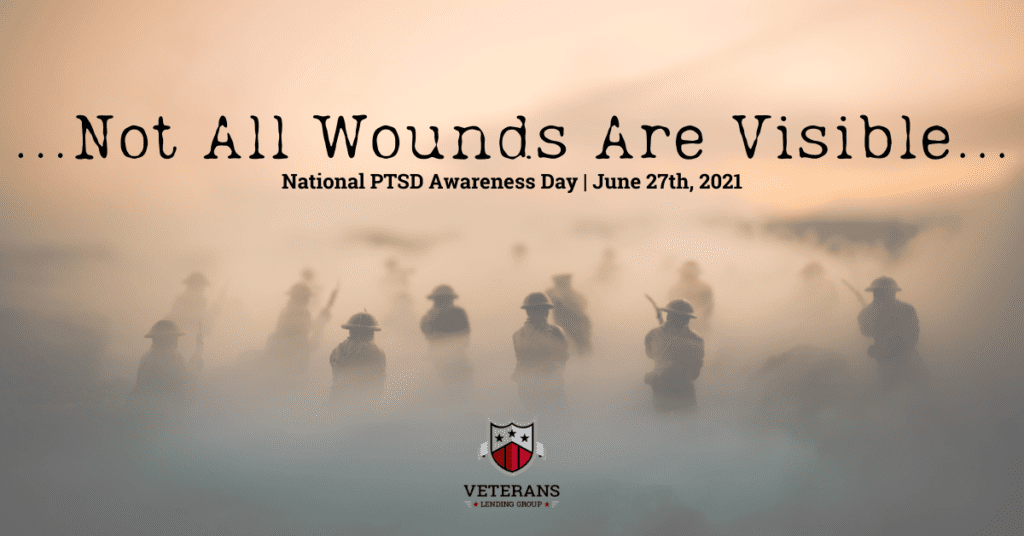June 27th is PTSD Awareness Day
With so many people impacted, we believe it is important to do our part and talk about what these people are going through on PTSD Awareness Day! Whether you can personally relate or are just learning more about the impact of PTSD for a friend or loved one, it’s more common than we think to know someone who has suffered from PTSD.
It’s also likely that you have encountered individuals who may seem to be okay on the outside but are quietly suffering on the inside. In hopes of getting everyone on the same page and bringing awareness, we’re setting out on a mission to bring awareness today and all days of the year!
What is PTSD?
PTSD or posttraumatic stress disorder is a stress and trauma-related psychiatric disorder. It can develop after a person experiences a life-threatening situation or exposure to a severely traumatic event. It is natural to feel afraid and not understand changes in the body’s response to high stress and trauma.
You may have heard the term, fight or flight, but what does that really mean in this context? Fight or flight is a typical and instinctive physiological response we all have. This usually occurs when someone is exposed to a threatening or stressful situation. People experience a range of reactions; however, they usually subside after the danger has passed. Someone suffering from PTSD has a heightened response and reaction even when they are no longer in danger.
History of National PTSD Awareness Day
National PTSD (Post-Traumatic Stress Disorder) Awareness Day is observed every year on June 27 in the United States. The day was first officially recognized by the US Senate in 2010, following the efforts of Senator Kent Conrad, who introduced the resolution in honor of North Dakota Army National Guard Staff Sergeant Joe Biel, who had taken his own life after struggling with PTSD. The day aims to raise awareness about the mental health condition that can develop in individuals who have experienced or witnessed a traumatic event, such as military combat, sexual assault, or a natural disaster. It also serves as a reminder to provide support and resources for those who are living with PTSD.
What can you do?
People suffering from PTSD may feel like they are a burden or feel like they are alone. They might not understand the changes they are going through mentally, physically, and emotionally. They might not be actively searching or reaching out for the help they need. It’s our duty to support them and be proactive so we can help people manage their PTSD and live fulfilling lives.
How Common is PTSD?
According to the U. S. Department of Veterans Affairs, going through trauma is not rare. About 6 of every 10 men (or 60%) and 5 of every 10 women (or 50%) experience at least one trauma in their lives.”
The following statistics below are based on the U. S. population only:
About 7 or 8 out of every 100 people (or 7-8%) will have PTSD at some point in their lives. About 8 million adults have PTSD during a given year. This is only a small portion of those who have gone through trauma. About 10 of every 100 women (or 10%) develop PTSD sometime in their lives. About 4 of every 100 men (or 4%) develop PTSD sometime in their lives.
Who is Affected?
Post-Traumatic Stress Disorder (PTSD) doesn’t discriminate and can develop in any person at any age. We especially come across individuals and their families battling this illness within the Military community. The people affected go beyond just those who are diagnosed. Friends, family, and even co-workers of those diagnosed are also affected by PTSD. We need to keep an open dialogue, provide education, and support our communities. Together, we can spread awareness and support those families in need.
Having an open conversation about a topic so personal can be perceived as taboo or uncomfortable to most. Mental health is very important and should never be disregarded. There is a stigma behind people seeking assistance for mental health and admitting they need help. It should never be a reason to turn a blind eye or stay hush-hush about PTSD.
Common Symptoms
Bad dreams, frightened thoughts, flashbacks of trauma, staying away from certain places, disconnecting from loved ones, being easily startled, feeling on edge or tense, not eating well, not sleeping well, angry outbursts, memory loss, negative thoughts about themselves or others, lack of social interest and/or hobbies.
What Can You Do?
Remember, not everyone suffering from PTSD shows apparent symptoms. It can be your neighbor you see smiling every morning when leaving the house. Maybe it’s your child who always tells you they are doing fine. It could even be your spouse who gives you a kiss goodnight and tells you constantly that they love you. It’s vital to speak with a medical professional for those who have symptoms or have been diagnosed.
Here are some tips on how to help someone with PTSD:
- Be a Supporter/Good Listener
Don’t pressure them into talking about it. It can be difficult for them to talk about their traumatic experiences. Being a good listener goes beyond verbal communication. It can be by reading their body language and seeing when they may be uncomfortable and comforting them in the way they are most positively receptive.
- Build a Line of Communication & Trust
Someone with PTSD has gone through many changes and can be on edge or feel threatened. Ensure you provide a judgment-free environment, create a planned routine with your loved one and keep your promises. Remember, never over-promise, and be very straightforward and honest with them.
- Positive Reinforcement
Point out their positive qualities and praise their success. They need to know they are being recognized and feel great about their accomplishments (no matter how big or small). Also, encourage them to surround themselves with others going through similar situations so they don’t feel alone. Support groups are a perfect setting for this.
- Recognize Behavioral Patterns & Triggers
It is very important to stay in tune with their mood changes and understand what may trigger a PTSD episode. Also, try and communicate with them what their triggers may be. Some common triggers (different for everyone) are sounds, smells, sights, physical interactions, weathers/seasons, relationships (can be specific people), life stressors (i.e., school, work, finances), funerals, hospitals, getting injured, strong internal emotions (feeling helpless, trapped), feeling hungry, lack of sleep, thirsty.
- Properly Handle Volatile Episodes
PTSD can take a heavy toll on loved ones. It’s important to try and remain as calm and levelheaded as possible when a loved one goes through a volatile episode. Try and give them space so they don’t feel cornered or threatened. Ask them how you can help them at that moment or get them out to a change in scenery. Most importantly, put safety first. Call 911 when needed or you fear your loved one may hurt themselves or others.
Resources to Share for National PTSD Awareness Day
Know that you and your loved ones are never alone and it’s okay to ask for help.
If you or a loved one may be experiencing symptoms of PTSD or need further support, please reach out to a medical professional.
You can also call the toll-free National Suicide Prevention Lifeline at 1-800-273-TALK (1-800-273-8255) and press 1 if you are a Veteran
If you’re experiencing an emergency and need urgent assistance, please call 911.
Many resources are available here: www.nimh.nih.gov/findhelp.
For more information about PTSD, visit: https://medlineplus.gov/posttraumaticstressdisorder.html or visit https://www.mentalhealth.va.gov/index.asp




